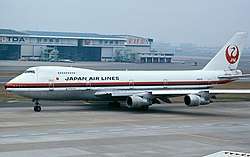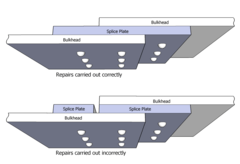Japan Airlines Flight 115
Japan Airlines Flight 115 was a scheduled domestic Japan Airlines passenger flight from Tokyo's Haneda Airport to Itami Airport, Osaka Prefecture. On June 2, 1978, the aircraft suffered tailstrike damage on landing at Itami, which was incorrectly repaired resulting in a catastrophic failure on a subsequent flight seven years later.
 JA8119, the aircraft involved, seen in 1984 after being repaired and one year before it crashed | |
| Incident | |
|---|---|
| Date | June 2, 1978 |
| Summary | Tailstrike caused by pilot error |
| Site | Itami Airport, Osaka, Japan |
| Aircraft | |
| Aircraft type | Boeing 747SR-146 |
| Operator | Japan Airlines |
| Registration | JA8119 |
| Flight origin | Haneda Airport |
| Destination | Itami Airport |
| Occupants | 394 |
| Passengers | 379[1] |
| Crew | 15 |
| Fatalities | 0 |
| Injuries | 25[1] |
| Survivors | 394 (all) |
Aircraft and crew
The aircraft was a Boeing 747SR, registration JA8119 and had first flown on January 28, 1974. It had flown for 8,830 hours at the time of the tailstrike incident.[2]:4
The 41-year-old captain had 7,912 flight hours, including 220 hours on the Boeing 747. The 36-year-old first officer had 564 flight hours, with 286 hours on the 747. The 44-year-old flight engineer had 4,070 hours and was the most experienced on the Boeing 747 out of all crew members, having flown 2,780 hours on it.[2]:3–4
Tailstrike incident
On June 2, 1978, Flight 115 was carrying out an instrument landing system (ILS) approach to runway 32L at Itami Airport in Toyonaka-shi Province but bounced heavily on landing. The pilots pulled the nose up, causing a severe tailstrike. There were no fatalities, but 25 people were injured, 23 minor and 2 serious. The tailstrike cracked open the aft pressure bulkhead. The damage was repaired by Boeing technicians and the aircraft was returned to service.[2][1][3]
Aftermath
On August 12, 1985, seven years after the tailstrike incident, JA8119 was operating Japan Airlines Flight 123 on the same route, Haneda to Itami. On ascent out of Haneda, twelve minutes into the flight, the tailstrike repair failed catastrophically. The rear bulkhead burst open, the vertical stabilizer was torn off and all hydraulic systems were damaged, rendering the aircraft uncontrollable. 32 minutes later, the aircraft crashed into Mount Takamagahara near Ueno, Gunma Prefecture, killing 520 out of the 524 people on board. This was the deadliest single aircraft accident in history.[4]

The crash investigation found that the tailstrike from 1978 had been improperly repaired. Boeing's specification for the damaged bulkhead required one continuous splice plate with three rows of rivets but the Boeing technicians carrying out the repair substituted two discontinuous splice plates, placed parallel to the joint. The post-repair inspection by JAL did not discover the defect as it was covered by overlapping plates.[1]
In an unrelated incident on 19 August 1982, while under the control of the first officer, JA8119 suffered a runway strike of the No. 4 engine on landing at Chitose Air Base in poor visibility. This was repaired successfully and the aircraft again returned to service. This incident did not contribute to the Flight 123 accident.
Flight number
Japan Airlines still uses the flight number 115, with the same route, but with a Boeing 787-8.[5]
See also
- China Airlines Flight 611 - a 2002 aviation accident also caused by a faulty repairs to a tailstrike that occurred 22 years prior.
- Japan Airlines Flight 123 - a 1985 aviation accident caused by the incorrect repair job done to JAL 115.
References
- "AIRCRAFT ACCIDENT INVESTIGATION REPORT Japan Air Lines Co., Ltd. Boeing 747 SR-100, JA8119 Gunma Prefecture, Japan August 12, 1985" (PDF). Aircraft Accident Investigation Commission. June 19, 1987. Retrieved April 21, 2019.
- "日本航空(株)所属 ボーイング式747SR-100型 JA8119に関する航空事故報告書" [Aviation accident report for Boeing 747SR-100 JA8119 belonging to Japan Airlines Co., Ltd.] (PDF) (in Japanese). Aircraft Accident Investigation Commission. December 14, 1978. Retrieved May 27, 2020.
- Ranter, Harro. "ASN Aircraft accident Boeing 747SR-46 JA8119 Osaka-Itami Airport (ITM)". aviation-safety.net. Aviation Safety Network. Retrieved January 31, 2019.
- Ranter, Harro. "ASN Aircraft accident Boeing 747SR-46 JA8119 Ueno Village, Tano District, Gunma Prefecture". aviation-safety.net. Aviation Safety Network. Retrieved January 31, 2019.
- "JL115 - JAL JL 115 Flight Tracker". FlightStats. Retrieved May 31, 2020.